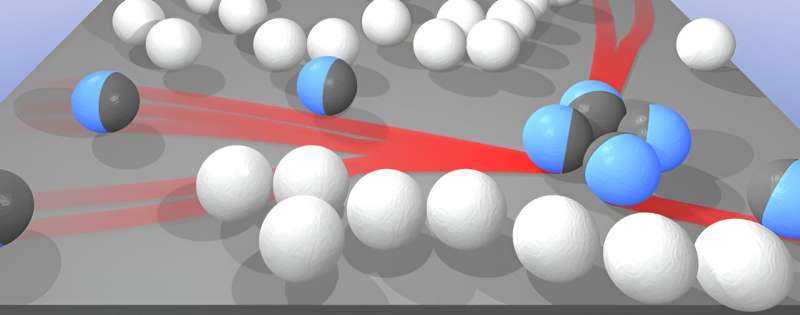This article has been reviewed according to Science X's editorial process and policies. Editors have highlighted the following attributes while ensuring the content's credibility:
fact-checked
peer-reviewed publication
trusted source
proofread
Q&A: Understanding coordination mechanisms in decentralized systems

Did you know that when a group of robots or bacteria moves in a space where there are several free objects, they deflect these objects so they can pass? An international research team managed to show that the trail left by this movement contributes to the formation of groups, functioning as an effective communication mechanism between them, in a study now published in Nature Communications.
The first author, Cristóvão Dias, is a researcher at the Department of Physics and at the Center of Theoretical and Computational Physics at the Faculty of Sciences of the University of Lisbon (Ciências ULisboa) (Portugal). Manish Trivedi and Giorgio Volpe (University College London, United Kingdom), Giovanni Volpe (University of Gothenburg, Sweden) and Nuno Araújo (Ciências ULisboa) are co-authors of this article.
Understanding coordination mechanisms in decentralized systems has the potential to positively impact several fields of knowledge, from biology to robotics. To find out how this collaboration came about, the relevance of these scientific advances, and the next research steps, we spoke with the authors.
How did the opportunity to develop this work arise?
Nuno Araújo (NA): Over the last few years, in the context of a doctoral network funded by the European Commission, we have been collaborating with these two groups, one from the University of College of London and the University of Gothenburg (Sweden), in the study of the movement of active particles such as bacteria, micro robots, and others, in disordered environments.
Observing the way they interact with the surrounding environment, changing it, and how this impacts the movement of the particles themselves, we identified a non-trivial behavior that led to the formation of groups and developed methods to better understand the mechanisms involved.
What does this study consist of?
Cristóvão Dias (CD): This study addresses a system composed of Janus-type colloidal particles which, like the Greek god Janus, have two different "faces." In our case, these are spherical particles in which one of the hemispheres is covered by graphite, giving them propulsion in a specific direction, behaving like a robot on a microscale.
Our focus is to understand how these active particles, which act as autonomous agents, interact with the surrounding environment, changing it, and how the memory of these changes facilitates coordination, culminating in the formation of groups.
What are the main results achieved?
CD: When an active particle moves in a medium with moving objects, it collides with them, ending up deflecting them. This leads to the formation of channels that can be used by other active particles.
Combining experimental and computational methods, what we were able to show is that the formation of these channels promotes a greater encounter between active particles and consequently the formation of groups. Thus, despite the species involved not being able to communicate directly, an ability to coordinate their action emerges and form groups efficiently.
How important is this work for society and science?
NA: This work paves the way for the introduction of methods that allow the exploration of complex means by active systems devoid of reasoning. The knowledge produced contributes to the advancement of scientific understanding, but also has practical implications, offering innovative approaches for the development of autonomous systems capable of operating efficiently in challenging environments.
This in-depth understanding of coordination mechanisms in decentralized systems has the potential to positively impact several fields of knowledge, from biology to robotics, helping to understand how nature developed efficient coordination mechanisms and helping to implement autonomous systems with minimal complexity of individual units.
What are the next steps?
NA: The next steps involve deepening our understanding of this coordination mechanism and exploring the implications in a more general context. We intend to apply this knowledge to improve the efficiency and adaptability of decentralized systems to different length and time scales.
CD: This work highlights the importance of exploring and understanding the complex interactions between active systems and their surroundings and leveraging these principles to improve the efficiency and adaptability of autonomous systems in diverse areas.
More information: Cristóvão S. Dias et al, Environmental memory boosts group formation of clueless individuals, Nature Communications (2023). DOI: 10.1038/s41467-023-43099-0
Journal information: Nature Communications
Provided by University of Lisbon




















